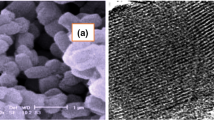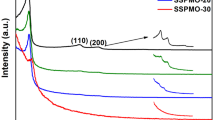Abstract
The ensemble system PyH-SBA-15-Cu2+ was obtained via coordination interaction of pyrene derivative-functionalized mesoporous SBA-15 and Cu2+, and applied for the selective and sensitive detection of H2S over pH 6.0–12.0 in aqueous media. The sensing strategy was designed on the basis of the H2S-induced dissolution of Cu2+ from PyH-SBA-15-Cu2+. Cu2+ has good binding affinity to N atoms in PyH-SBA-15; therefore, the organic–inorganic hybrid ensemble PyH-SBA-15-Cu2+ was formed, which is nonfluorescent in aqueous solution because of the Cu2+-promoted emission quenching of PyH-SBA-15. The addition of H2S induces the dissolution of PyH-SBA-15-Cu2+ by the formation of stable CuS, thereby producing fluorescence revival of PyH-SBA-15. The correlative “turn-on” fluorescence signals of this ensemble system are linearly proportional to [H2S] in the concentration region of 0–1.0 × 10−4 M, showing a low detection limit of 3.7 × 10−7 M. Other common anions do not induce distinct fluorescence changes. When using the fluorescence intensity signal changes of PyH-SBA-15 as outputs and Cu2+ and S2− as inputs, PyH-SBA-15 can act as an XNOR logic gate.







Similar content being viewed by others
References
Wu J, Kwon B, Liu W, Anslyn EV, Wang P, Kim JS. Chromogenic/fluorogenic ensemble chemosensing systems. Chem Rev. 2015;115:7893–943.
Sedgwick AC, Wu L, Han HH, Bull SD, He XP, James TD, et al. Excited-state intramolecular proton-transfer (ESIPT) based fluorescence sensors and imaging agents. Chem Soc Rev. 2018;47:8842–80.
Xiong B, Peng L, Cao X, He Y, Yeung ES. Optical analysis of biological hydrogen sulphide: an overview of recent advancements. Analyst. 2015;140:1763–71.
Kaushik R, Ghosh A, Jose DA. Recent progress in hydrogen sulphide (H2S) sensors by metal displacement approach. Coord Chem Rev. 2017;347:141–57.
Wu D, Sedgwick AC, Gunnlaugsson T, Akkaya EU, Yoon J, James TD. Fluorescent chemosensors: the past, present and future. Chem Soc Rev. 2017;46:7105–23.
Zhou X, Lee S, Xu Z, Yoon J. Recent progress on the development of chemosensors for gases. Chem Rev. 2015;115:7944–8000.
Lin VS, Chen W, Xian M, Chang CJ. Chemical probes for molecular imaging and detection of hydrogen sulfide and reactive sulfur species in biological systems. Chem Soc Rev. 2015;44:4596–618.
Hu Y, Kang J, Zhou P, Han X, Sun J, Liu S, et al. A selective colorimetric and red-emitting fluorometric probe for sequential detection of Cu2+ and H2S. Sensors Actuators B Chem. 2018;255:3155–62.
Busschaert N, Caltagirone C, Rossom WV, Gale PA. Applications of supramolecular anion recognition. Chem Rev. 2015;115:8038–155.
Yun JY, Jo TG, Han J, Jang HJ, Lim MH, Kim C. A highly sensitive and selective fluorescent chemosensor for the sequential recognition of Zn2+ and S2− in living cells and aqueous media. Sensors Actuators B Chem. 2018;255:3108–16.
Vengaian KM, Britto CD, Sekar K, Sivaraman G, Singaravadivel S. Phenothiazine-diaminomalenonitrile based colorimetric and fluorescence “turn-off-on” sensing of Hg2+ and S2−. Sensors Actuators B Chem. 2016;235:232–40.
Li H. A regenerated “turn on” fluorescent probe for sulfide detection in live cells and read samples based on dihydroxyhemicyanine-Cu2+ dye. Anal Chim Acta. 2018;1010:69–75.
Zhu Y, Cheng Z, Xiang Q, Zhu Y, Xu J. Rational design and synthesis of aldehyde-functionalized mesoporous SBA-15 for high-performance ammonia sensor. Sensors Actuators B Chem. 2018;256:888–95.
Lashgari N, Badiei A, Ziarani GM, Faridbod F. Isatin functionalized nanoporous SBA-15 as a selective fluorescent probe for the detection of Hg(II) in water. Anal Bioanal Chem. 2017;409:3175–85.
Zhao L, Li J, Sui D, Wang Y. Highly selective fluorescence chemosensors based on functionalized SBA-15 for detection of Ag+ in aqueous media. Sensors Actuators B Chem. 2017;242:1043–9.
Afshani J, Badiei A, Lashgari N, Ziarani GM. A simple nanoporous silica-based dual mode optical sensor for detection of multiple analytes (Fe3+, Al3+ and CN–) in water mimicking XOR logic gate. RSC Adv. 2016;6:5957–64.
Zhou H, Lv X, Zhang L, Gong A, Wu A, Liang Z, et al. A facile and in situ approach to fluorescent mesoporous silica and its applications in sensing and bioimaging. J Mater Chem C. 2014;2:9625–30.
Calero P, Hecht M, Martínez-Máñez R, Sancenón F, Soto J, Vivancos JL, et al. Silica nanoparticles functionalised with cation coordination sites and fluorophores for the differential sensing of anions in a quencher displacement assay (QDA). Chem Commun. 2011;47:10599–601.
Wang J, Guo W, Bae JH, Kim SH, Song J, Ha CS. Facile preparation of a multifunctional fluorescent nanosensor for chemical and biological applications. J Mater Chem. 2012;22:24681–9.
Li Y, Yu X, Yu T. Eu3+ based mesoporous hybrid material with tunable multicolor emission modulated by fluoride ion: application for selective sensing toward fluoride ion. J Mater Chem C. 2017;5:5411–9.
Sarkar S, Roy S, Sikdar A, Saha RN, Panja SS. A pyrene-based simple but highly selective fluorescence sensor for Cu2+ ions via a static excimer mechanism. Analyst. 2013;138:7119–26.
Wang J, Liu HB, Tong Z, Ha CS. Fluorescent/luminescent detection of natural amino acids by organometallic systems. Coord Chem Rev. 2015;303:139–84.
Gale PA, Caltagirone C. Anion sensing by small molecules and molecular ensembles. Chem Soc Rev. 2015;44:4212–27.
Wang Y, Sun H, Hou L, Shang Z, Dong Z, Jin W. 1,4-Dihydroxyanthraquinone- Cu2+ ensemble probe for selective detection of sulfide anion in aqueous solution. Anal Methods. 2013;5:5493–500.
Palanisamy S, Lee LY, Wang YL, Chen YJ, Chen CY, Wang YM. A water soluble and fast response fluorescent turn-on copper complex probe for H2S detection in zebra fish. Talanta. 2016;147:445–52.
Zhang L, Sun J, Liu S, Cui X, Li W, Fang J. Aminoquinoline-based fluorescent probe for detection of Cu2+ and hydrogen sulfide. Inorg Chem Commun. 2013;35:311–4.
Fiorucci S, Antonelli E, Mencarelli A, Orlandi S, Renga B, Rizzo G, et al. The third gas: H2S regulates perfusion pressure in both the isolated and perfused normal rat liver and in cirrhosis. Hepatology. 2010;42:539–48.
Liu H, Zhang B, Tan C, Liu F, Cao J, Tan Y, et al. Simultaneous bioimaging recognition of Al3+ and Cu2+ in living-cell, and further detection of F- and S2- by a simple fluorogenic benzimidazole-based chemosensor. Talanta. 2016;161:309–19.
Dong Z, Le X, Zhou P, Dong C, Ma J. An off–on–off” fluorescent probe for the sequential detection of Zn2+ and hydrogen sulfide in aqueous solution. New J Chem. 2014;38:1802–1808.
Jung JM, Lee JJ, Nam E, Lim MH, Kim C, Harrison RG. A zinc fluorescent sensor used to detect mercury (II) and hydrosulfide. Spectrochim Acta A. 2017;178:203–11.
Ma F, Sun M, Zhang K, Yu H, Wang Z, Wang S. A turn-on fluorescent probe for selective and sensitive detection of hydrogen sulfide. Anal Chim Acta. 2015;879:104–10.
Sen B, Mukherjee M, Pal S, Dhara K, Mandal SK, Khuda-Bukhsh AR, et al. A water soluble FRET-based ratiometric chemosensor for Hg(II) and S2- applicable in living cell staining. RSC Adv. 2014;4:14919–27.
Tregubov Andrey A, Nikitin Petr I, Nikitin Maxim P. Advanced smart nanomaterials with integrated logic-gating and biocomputing: dawn of theranostic nanorobots. Chem Rev. 2018;118:10294–348.
Szaciłowski K. Digital information processing in molecular systems. Chem Rev. 2008;108:3481–548.
Xue M, Yang Y, Chi X, Yan X, Huang F. Development of pseudorotaxanes and rotaxanes: from synthesis to stimuli-responsive motions to applications. Chem Rev. 2015;115:7398–501.
Funding
This work was supported by the National Natural Science Foundation of China (NSFC) (Grant Nos. 21567002, 31560014, 21966006), the Natural Science Foundation of Guangxi Province (Grant No. 2018GXNSFAA050015), and the Hundred-Talent Program of Guangxi Province.
Author information
Authors and Affiliations
Corresponding author
Ethics declarations
Conflict of interest
The authors declare that they have no conflict of interest.
Additional information
Publisher’s note
Springer Nature remains neutral with regard to jurisdictional claims in published maps and institutional affiliations.
Electronic supplementary material
ESM 1
(PDF 357 kb)
Rights and permissions
About this article
Cite this article
Liu, HB., Liang, Y., Liang, J. et al. Pyrene derivative-functionalized mesoporous silica–Cu2+ hybrid ensemble for fluorescence “turn-on” detection of H2S and logic gate application in aqueous media. Anal Bioanal Chem 412, 905–913 (2020). https://doi.org/10.1007/s00216-019-02302-2
Received:
Revised:
Accepted:
Published:
Issue Date:
DOI: https://doi.org/10.1007/s00216-019-02302-2




